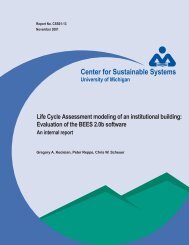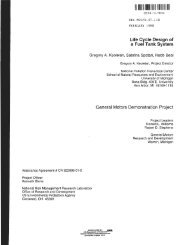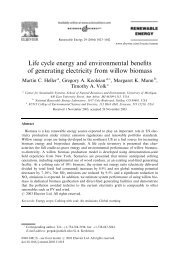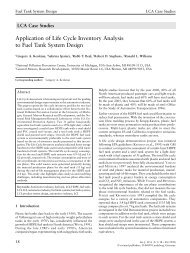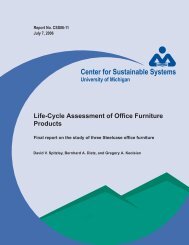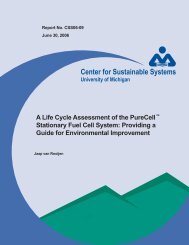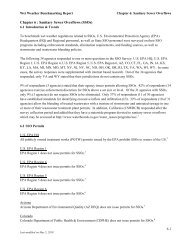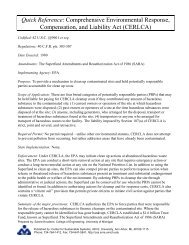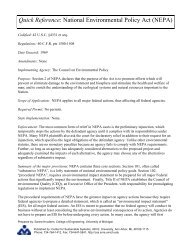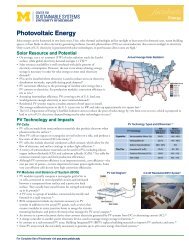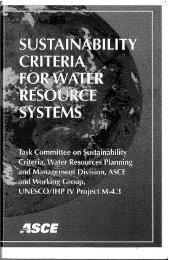emphasize sensible cooling capacity. The model only uses SEER to model efficiency and thus aregional standard based only on SEER is necessary for evaluation so the southeastern region wasselected.Unlike the previous analysis which assumed a new unit was purchase at the start <strong>of</strong> 1985, thisanalysis was done in order to evaluate the impacts from different aged systems from 2009 till2025. In essence, the model was modified by decreasing the time horizon to start at 2009 andexamining the results till 2025. In this case, the environmental burdens and consumersexpenses that occur before 2009 are ignored, but the burdens and costs thereafter areconsidered. The process LCA results are used to model the burdens from the production <strong>of</strong>subsequent units.Location pr<strong>of</strong>iles were created for each <strong>of</strong> the states in the region. A population weightedcooling load hour average (U.S. Census Bureau, 2009; Energy Star, 2009) was found for eachstate. The national temperature distribution was used to calculate the effective SEER for all thestates. The largest NERC region by area was used for each state in states where more than oneNERC region was present.It was assumed that a new regional standard <strong>of</strong> 16 SEER would take place at the start <strong>of</strong> 2009.While it is more likely that such a standard would be implemented in 2016 along with a revisednational standard, this is only 10 years before the end <strong>of</strong> the time horizon and thus in manyoptimization scenarios the final replacement would occur before such a regional standard wasadopted. Thus for the purposes <strong>of</strong> understanding the impact <strong>of</strong> a regional standard, the 16 SEERstandard was assumed to begin at the start <strong>of</strong> 2009. Process LCA results were used for theanalysis. The results for selected initial model years for selected states in the region are shownin Table 6.2. Results for all states are given the Appendix.Table 6.2: LCO Savings from Regional Standard Compared to Base Case Efficiency Scenari<strong>of</strong>or Select States and Initial Model Years.StateYear <strong>of</strong>CAC in2009 ObjectiveAL 1997orbeforeFL 1997orbeforeBase Case Efficiency 16 SEER Regional Standard SavingsDates <strong>of</strong>OptimalDates <strong>of</strong>OptimalfromRegional<strong>Replacement</strong>Objective <strong>Replacement</strong> StandardEnergy (MJ) 2009, 2016 913,000 2009, 2017 793,000 13.2 %GHG (CO2 eq.) 2009 52,700 2009 46,800 11.2 %Cost (2009$) 2009 $13,500 2009 $12,810 5.1 %2003 Energy (MJ) 2009, 2016 913,000 2009, 2017 793,000 13.2 %GHG (CO2 eq.) 2009 52,700 2009 46,800 11.2 %Cost (2009$) 2003, 2013 $13,190 2003, 2013 $12,700 3.7 %2008 Energy (MJ) 2008, 2015 907,000 2009, 2017 793,000 12.6 %GHG (CO2 eq.) 2008, 2015 51,200 2008, 2011 46,500 9.2 %Cost (2009$) 2008, 2016 $12,610 2008, 2013 $12,190 3.4 %Energy (MJ) 2009, 2013, 1,455,000 2009, 2017 1,260,000 13.4 %2019GHG (CO2 eq.) 2009 72,200 2009 63,500 12.0 %Cost (2009$) 2009 $20,550 2009 $18,850 8.2 %
FL 2003 Energy (MJ) 2009, 2013, 1,455,000 2009, 2017 1,260,000 13.4 %2019GHG (CO2 eq.) 2009 72,200 2009 63,500 12.0 %Cost (2009$) 2003, 2013 $20,430 2009 $18,850 7.7 %2008 Energy (MJ) 2008, 2012, 1,448,000 2009, 2017 1,260,000 13.0 %2019GHG (CO2 eq.) 2008, 2015 70,300 2008, 2011 63,400 9.8 %TX 1997orbeforeCost (2009$) 2008, 2016 $19,510 2008, 2013 $18,340 6.0 %Energy (MJ) 2009, 2016 1,084,000 2009, 2017 939,000 13.3 %GHG (CO2 eq.) 2009 66,200 2009 58,400 11.8 %Cost (2009$) 2009 $16,600 2009 $15,470 6.8 %2003 Energy (MJ) 2009, 2016 1,084,000 2009, 2017 939,000 13.3 %GHG (CO2 eq.) 2009 66,200 2009 58,400 11.8 %Cost (2009$) 2003, 2013 $16,360 2009 $15,470 5.4 %2008 Energy (MJ) 2008, 2012, 1,077,000 2009, 2017 939,000 12.8 %2019GHG (CO2 eq.) 2008, 2015 64,300 2008, 2011 58,100 9.8 %Cost (2009$) 2008, 2016 $15,640 2008, 2013 $14,880 4.9 %The results for all <strong>of</strong> the states showed that units older than 2003 should be replaced at the start<strong>of</strong> the time horizon in order to minimize energy or GHG emissions under the base case scenario.Units older than 1997 should also be replaced in 2009 in order to minimize cost. The firstreplacement follows a similar pattern in the regional standard scenario, but in this case allexisting units would be replaced in 2009 in order to minimize energy.For the model years evaluated, the results under this example regional standard scenario showthat consumers in these southeast states who follow a optimal replacement pattern starting in2009, could expect to reduce life cycle energy consumption by about 13%, GHG emissions byabout 9‐12%, or cost by 2‐8%.6.3 Replacing with Higher Efficiency UnitsIt is helpful for homeowners with existing CAC units to know when they should replace theirCACs. The same time horizon modifications to the model used in the regional standard analysisdescribed in Section 6.2 were also used in this analysis. The 2009 to 2025 time horizon wasused to compare the results <strong>of</strong> purchasing a new unit at the minimum standard or at a higherefficiency unit such as an Energy Star model for homeowners with existing CACs <strong>of</strong> variousmodel years. It was assumed that in either case the homeowner started out with a unit that hadan efficiency <strong>of</strong> the average unit sold in the year it was purchased. All subsequent purchaseswere either made at the minimum efficiency level or at the minimum Energy Star qualifyinglevel. This analysis was done assuming a 16 SEER standard in 2016 and that the Energy Starstandard would increase to 17.5 SEER at that time. However, since the new standard isscheduled to take effect in June, it was assumed that homeowners would have the opportunityto purchase units at the start <strong>of</strong> 2016 before the new standard took effect. As a result, 2017 isactually the first year when the standards would change the purchasing decision. According to
- Page 4: Document DescriptionLIFE CYCLE OPTI
- Page 8 and 9: 4.3 Energy Intensity ..............
- Page 10 and 11: List of TablesTable 1.1: Cooling Lo
- Page 12 and 13: 1 IntroductionMechanical air condit
- Page 14 and 15: The overall demand for space coolin
- Page 16 and 17: Cooling is provided when the liquid
- Page 18 and 19: 2 Methodology2.1 Life Cycle Assessm
- Page 20 and 21: chart. Replacing a product with a m
- Page 22 and 23: Each component was assigned to an a
- Page 24 and 25: Indoor UnitThe indoor unit was assu
- Page 26 and 27: Index (10 SEER =1)2.502.001.501.000
- Page 28 and 29: Producer costs for higher and lower
- Page 30 and 31: Figure 3.6: North American Electric
- Page 32 and 33: Table 3.5: Summary of Bin‐Based M
- Page 34 and 35: 3.5 End‐of‐LifeIt was assumed t
- Page 36 and 37: RefrigerantsAs described in Section
- Page 38 and 39: 5 Results and Discussion5.1 Model A
- Page 40 and 41: 5.3 Comparing Optimal Replacement t
- Page 42 and 43: 4500GHG Abated (kg CO2 eq.)40003500
- Page 44 and 45: Table 5.7: Impact of Carbon Price o
- Page 46 and 47: Ann Arbor GHG$676 $1,188 $1,188Ann
- Page 50 and 51: Energy Star, the average premium fo
- Page 52 and 53: holding period for minimizing cost
- Page 54 and 55: 7.3 Policy ImplicationsThis researc
- Page 56 and 57: 8 BibliographyAHRI. (2008). 2008 St
- Page 58 and 59: Kim, H. C., Keoleian, G. A., & Hori
- Page 60 and 61: AppendixA.1 Energy IntensityMuch of
- Page 62 and 63: A.2 LCO Results of Standard Efficie
- Page 64 and 65: A.3 Comparison of Optimal to Typica
- Page 66 and 67: Table A.0.7: LCO Results for 16 SEE
- Page 68 and 69: Table A.0.9: LCO Results for 15 SEE
- Page 70 and 71: Table A.0.11: LCO Results for 17 SE
- Page 72 and 73: Table A.0.13: Comparison of Optimal
- Page 74 and 75: 2008 Energy 2008, 2012, 1,448,000 2
- Page 76 and 77: SouthCarolina1992 Energy(MJ)GHG(CO2
- Page 78 and 79: 2017Cost (2009$) 2003, 2013 $7,770
- Page 80 and 81: A.8 High Efficiency CAC Rebate Surv
- Page 82: Memphis Light, Gas and Water Memphi



